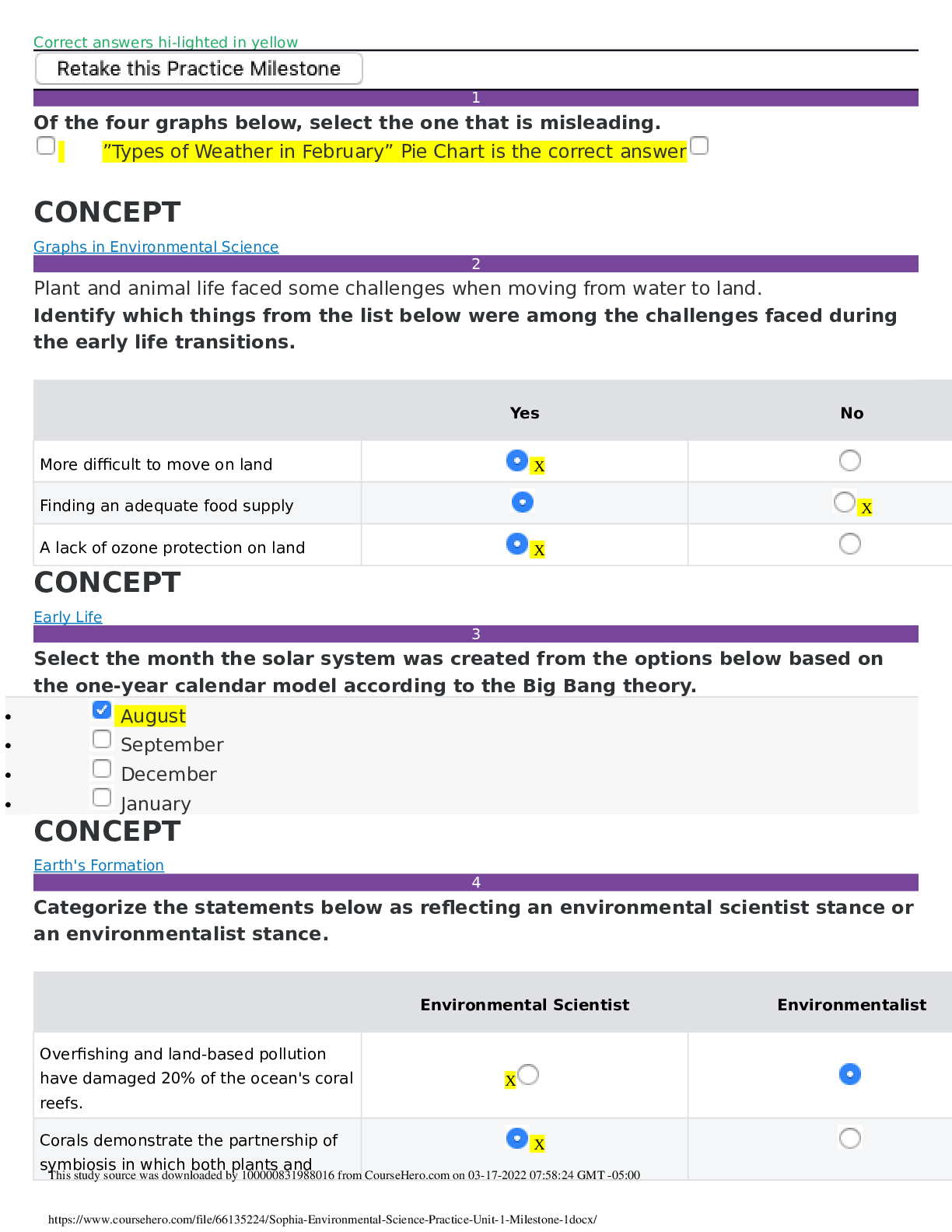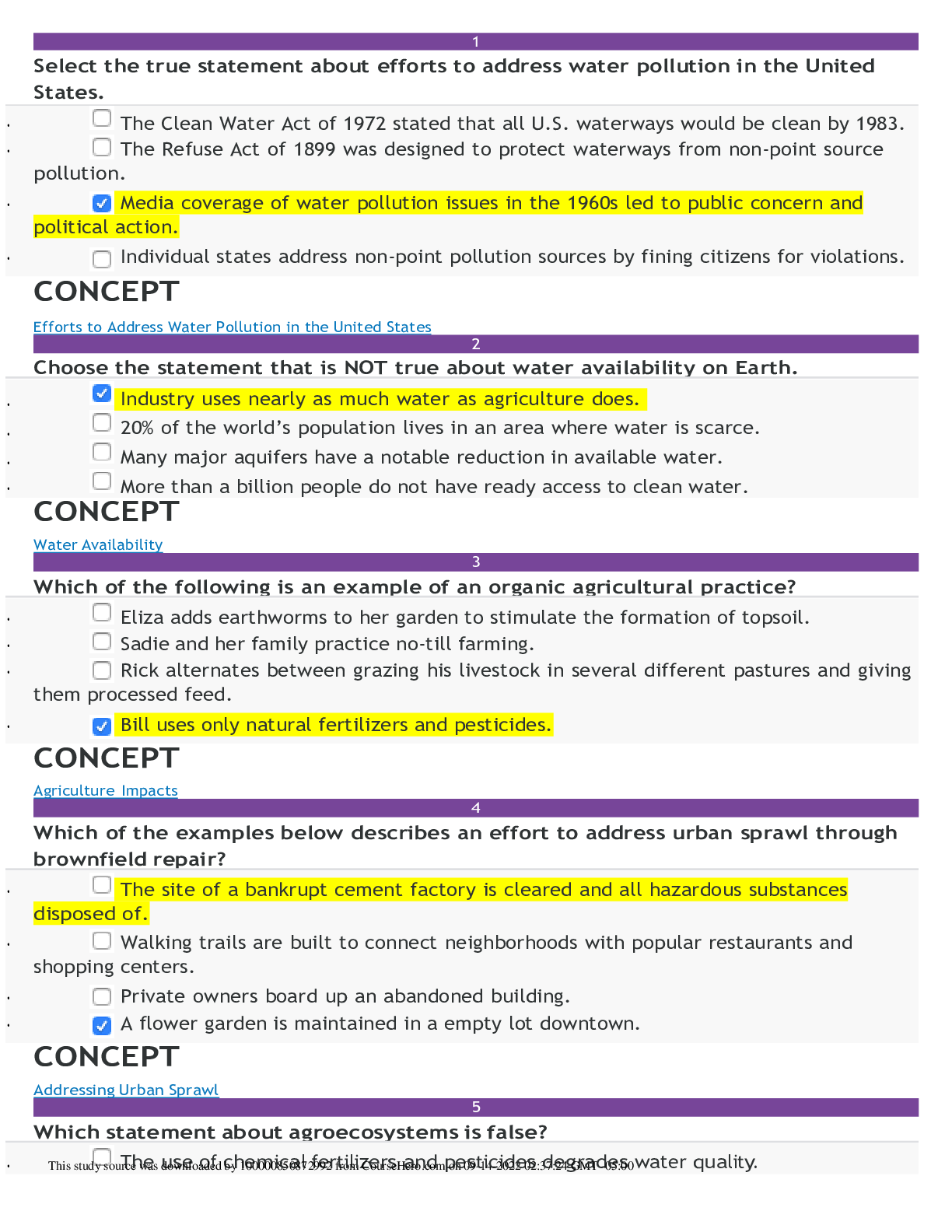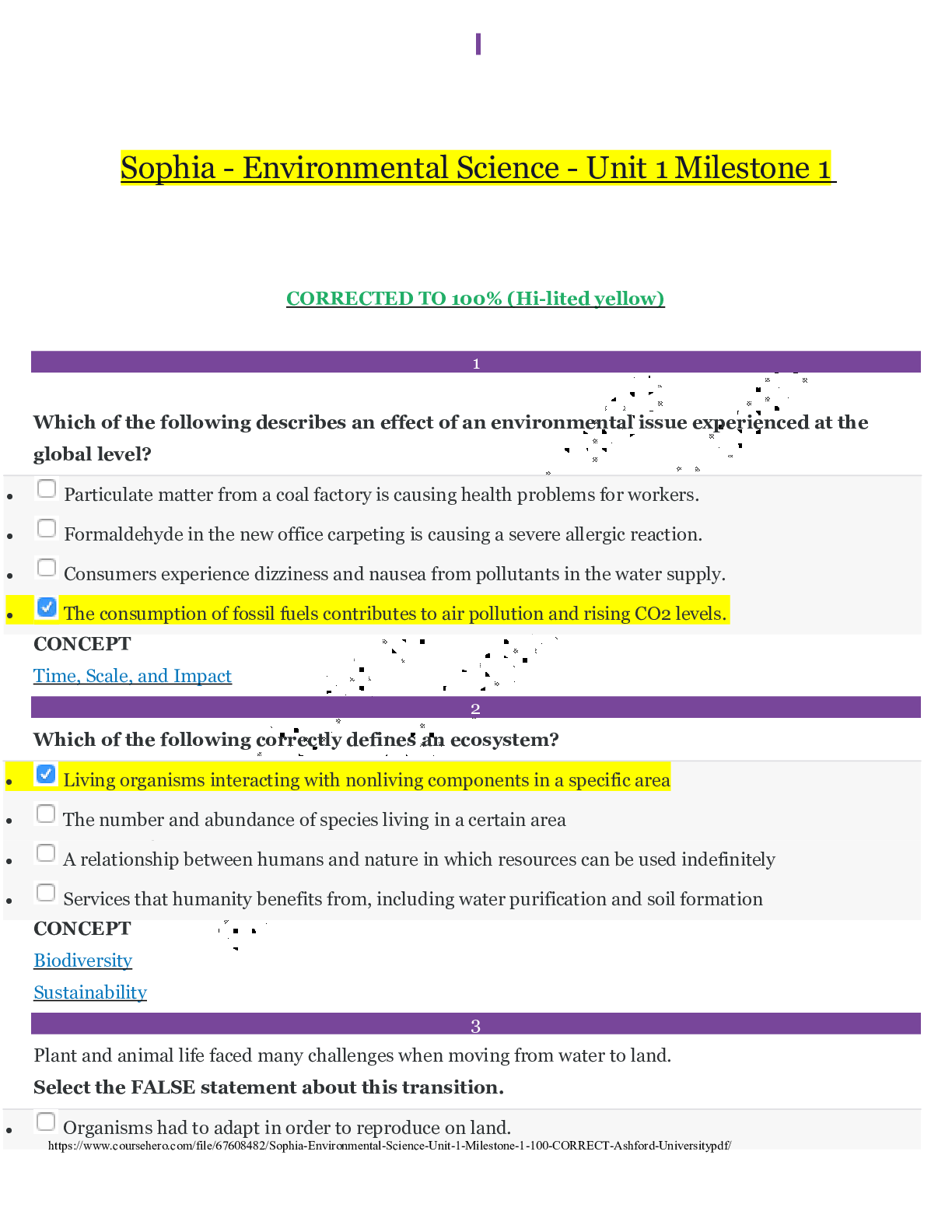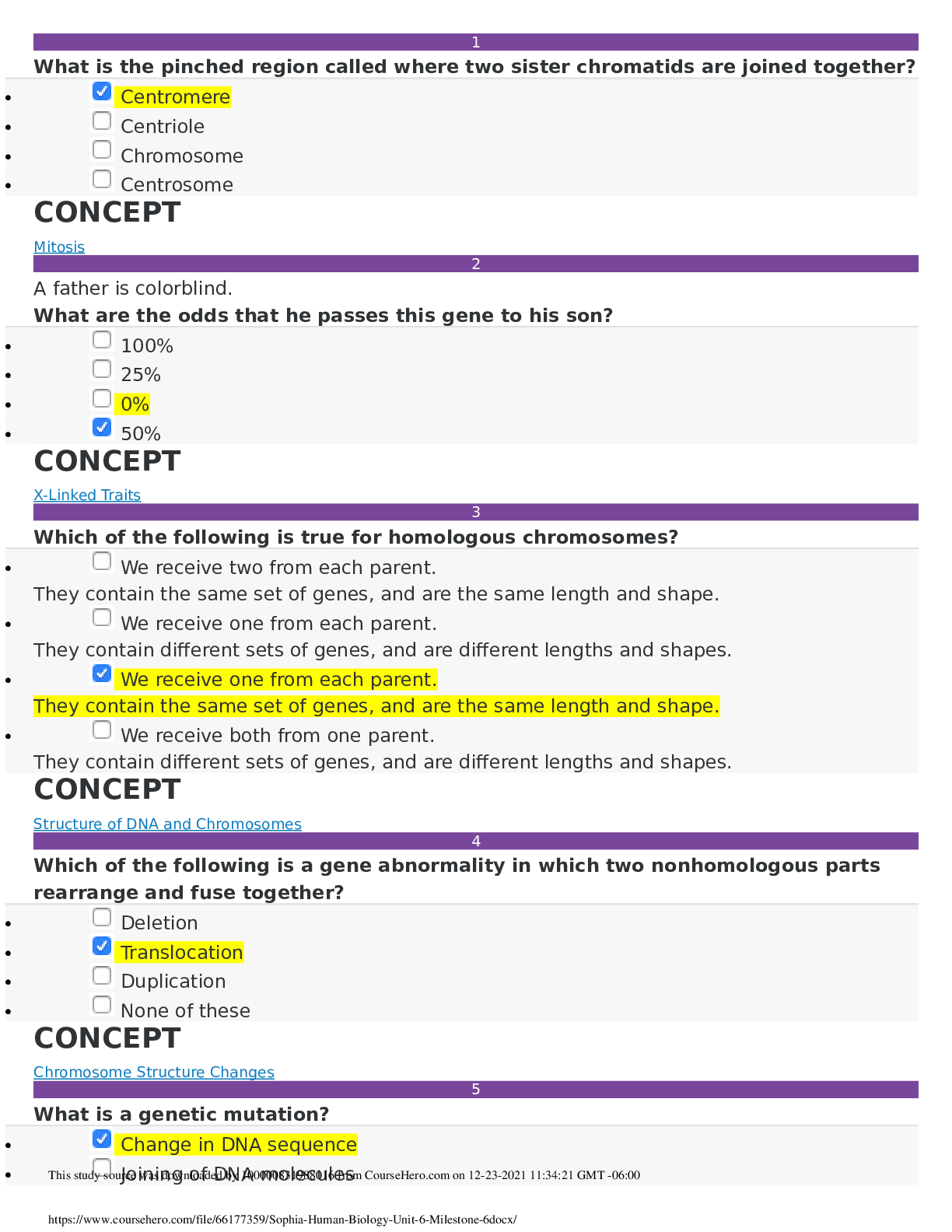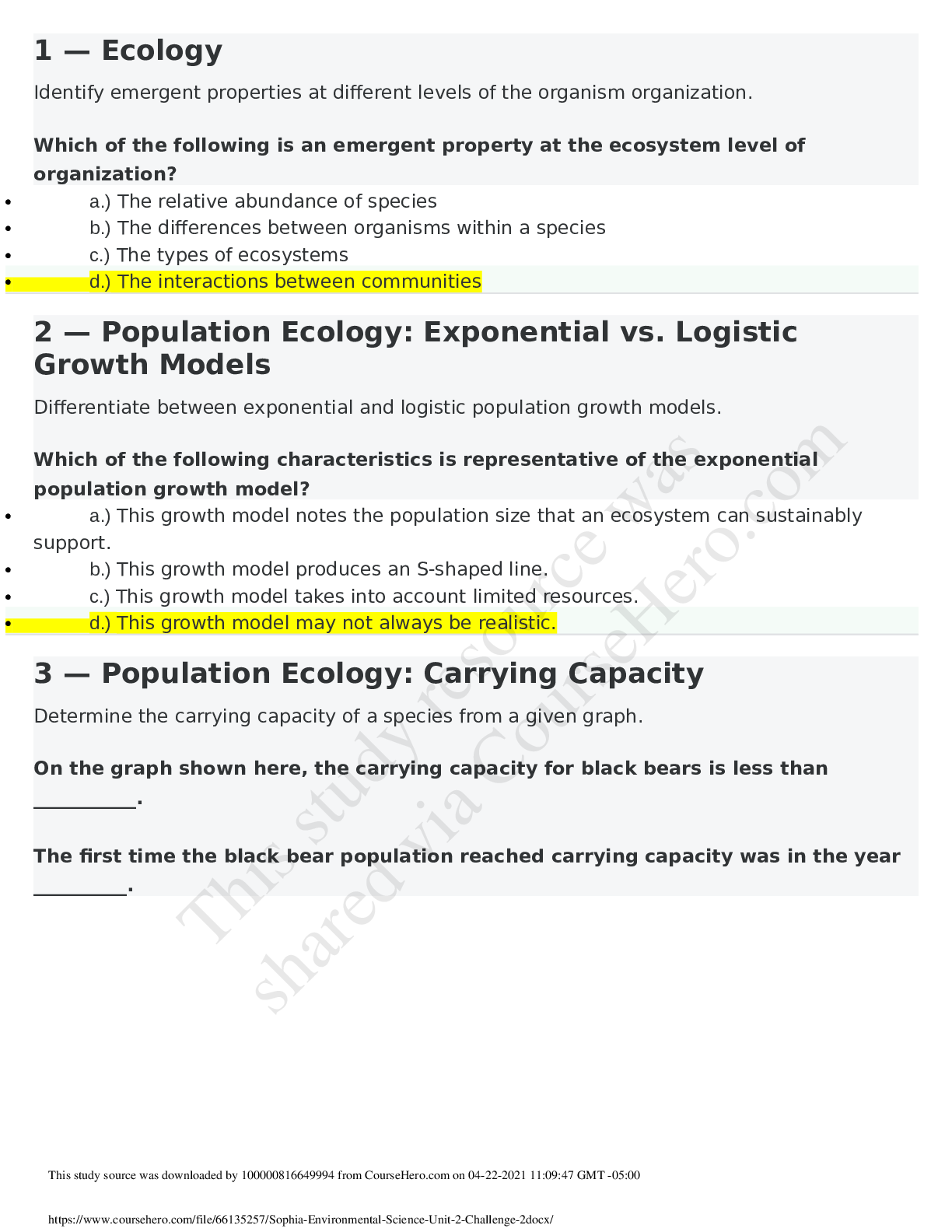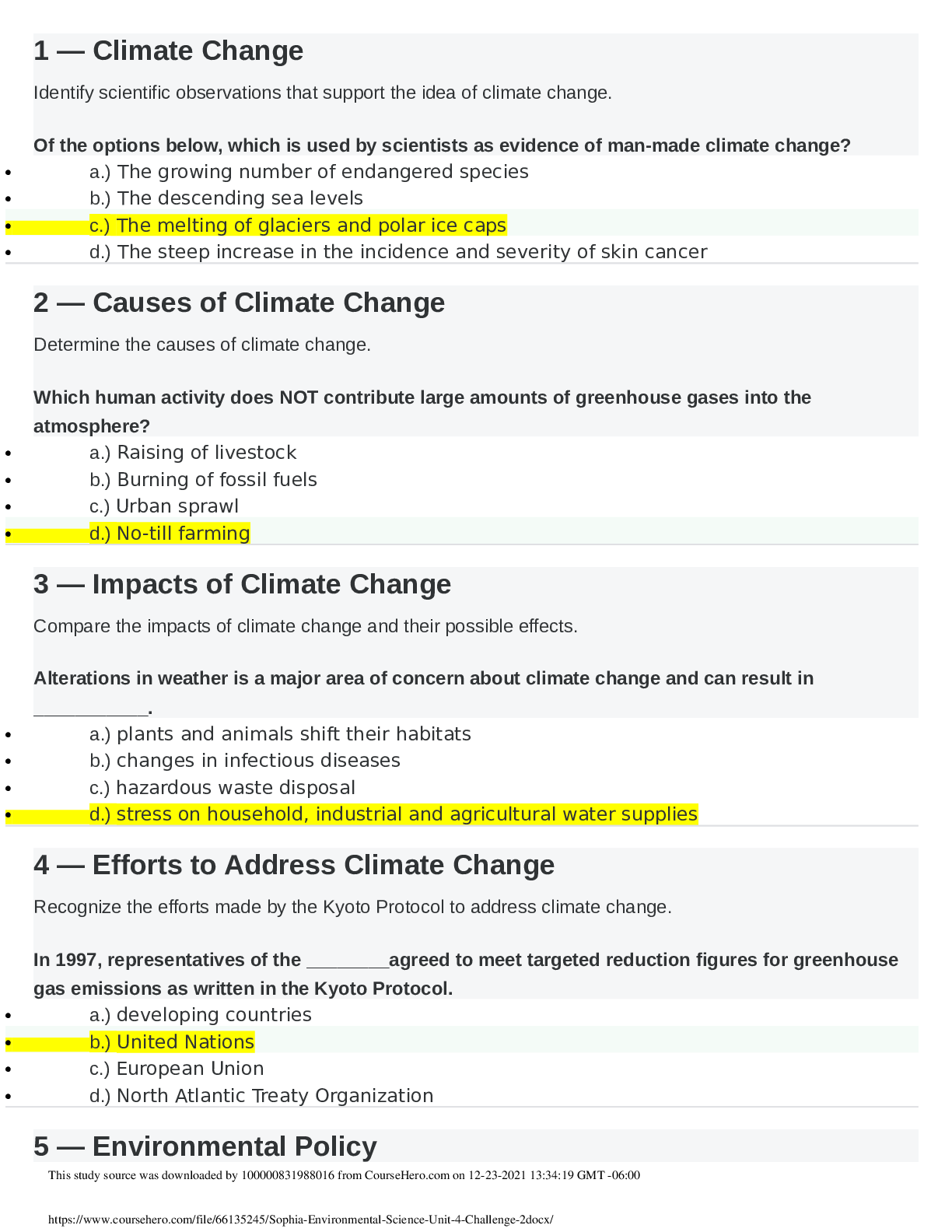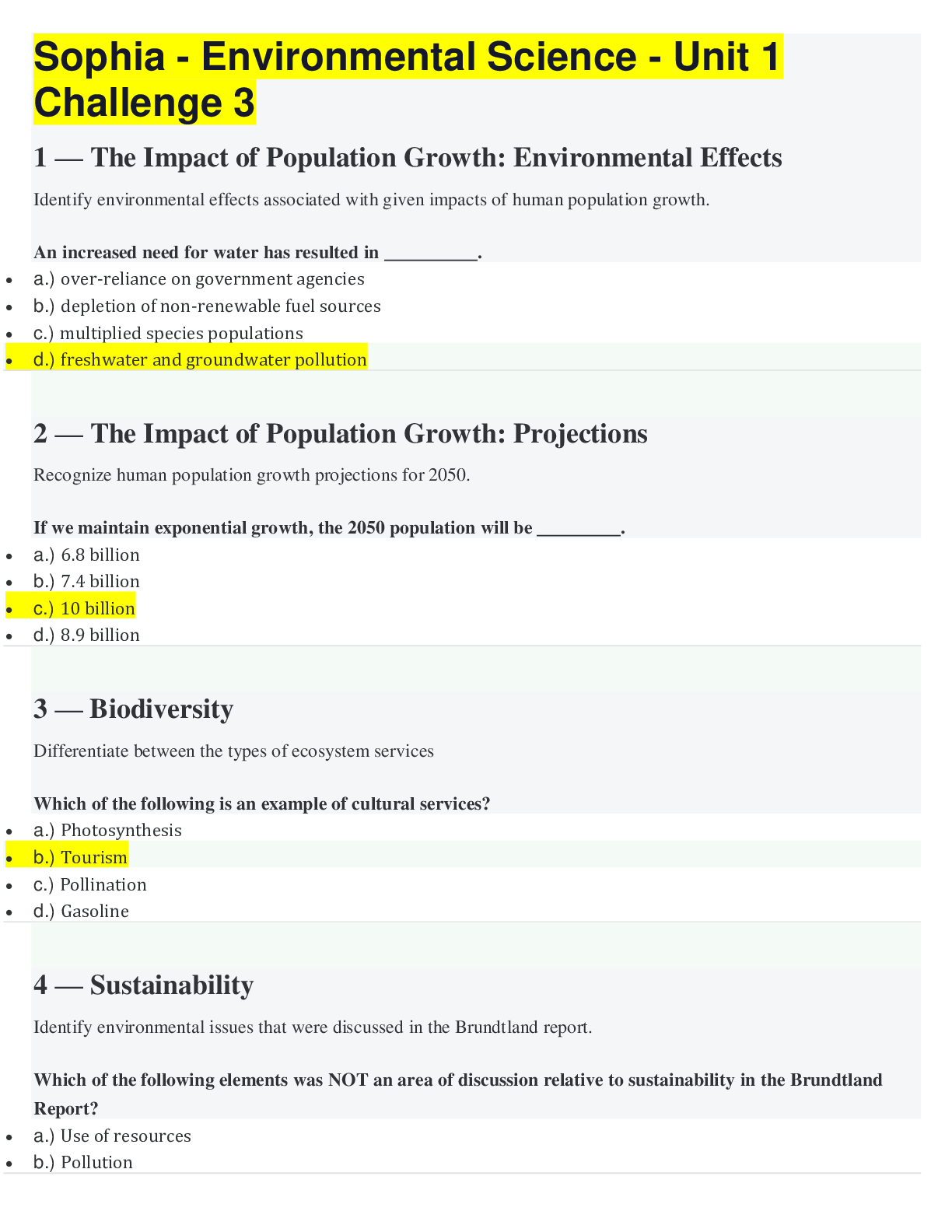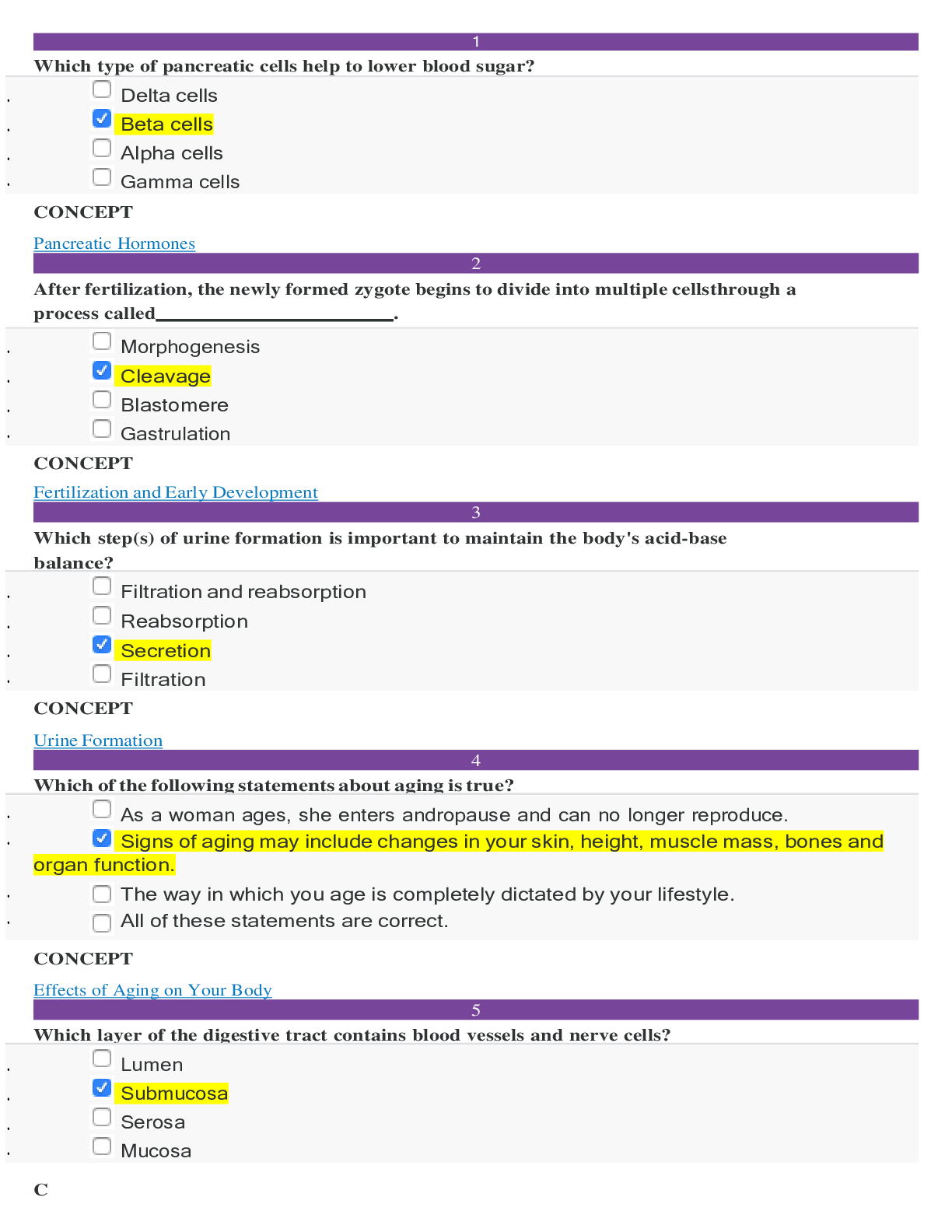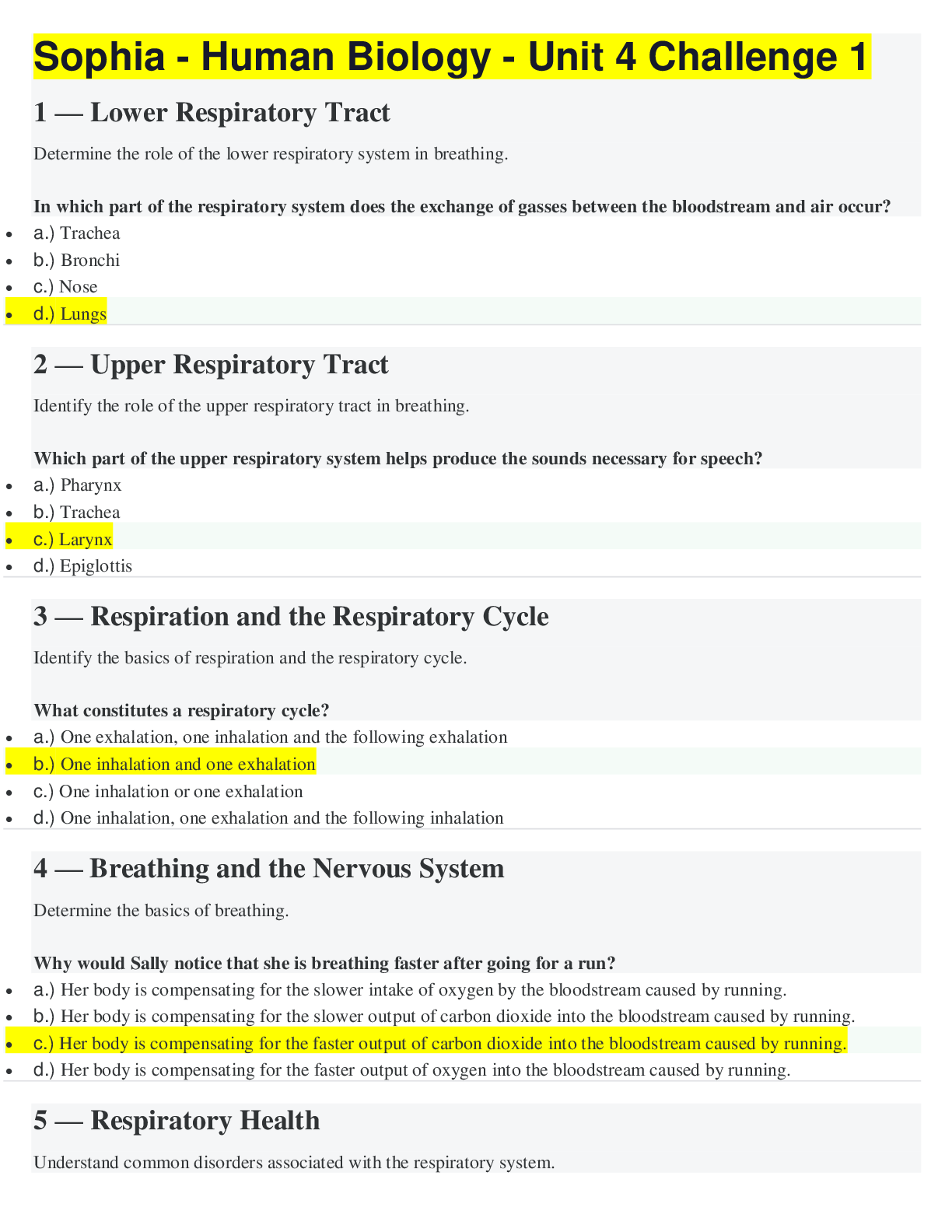Social Sciences > EXAM > Ashford University - SOPHIA PATHWAY Sophia - Environmental Science - Final Milestone/ Rated A. (All)
Ashford University - SOPHIA PATHWAY Sophia - Environmental Science - Final Milestone/ Rated A.
Document Content and Description Below
Sophia - Environmental Science - Final Milestone 1 Which of the examples below describes an effort to address urban sprawl through urban green space? • A new restaurant is constructed on a lot ... on the edge of town, bypassing several vacant lots within the city. • The city converts an old factory downtown into affordable housing for young people. • The city razes a former dry cleaners downtown, cleans up the chemicals in the soil and builds a sculpture garden. • A small city maintains a park and forest within its downtown as new businesses build around it. CONCEPT Addressing Urban Sprawl 2 Of the options below, which is an example of a point source of water pollution? • Fertilizers and pesticides from the valley’s farming operations seep into groundwater. • Salt from road de-icing is swept into the city’s storm sewers. • A rainstorm flushes litter and pet waste from surrounding parks into a nearby lake. • A housing development is built over a garbage dump that was buried and abandoned. CONCEPT Water Pollution 3 Choose the statement that is NOT true about conditions within the given biome. • Temperate grasslands are in the wetter areas of the temperate zone. • Tundras are very cold with very little rainfall. • Steppes are cold grasslands with little precipitation. • All deserts have extremely low precipitation levels. CONCEPT Biomes 4 Which of the following is true about the ecological footprints of the U.S. and developing countries? • The U.S. standard of living requires two hectares of land per person, but a developing nation’s standard of living requires 0.2 hectares of land per person. • The U.S. standard of living requires 15 hectares of land per person, but a developing nation’s standard of living requires 10 hectares of land per person. • The U.S. standard of living requires 10 hectares of land per person, but a developing nation’s standard of living requires one hectare of land per person. • The U.S. standard of living requires five hectares of land per person, but a developing nation’s standard of living requires 0.5 hectares of land per person. CONCEPT Human Population Growth 5 The Green Revolution contributed to a population explosion due to research and technology breakthroughs in the mid-1900s. Select one statement that is NOT a result of these breakthroughs. • Fertilizers were chemically produced, which improved food supplies. • Advances were made in sanitation and medicine that improved lives. • All nations became stronger and more self-sufficient as the population increased. • Improvements to agricultural crops increased production worldwide. CONCEPT Human Arrival and Expansion 6 What is one goal of the sustainability movement? • To encourage the use of coal • To manage human population growth • To decrease oxygen in the atmosphere • To promote deforestation practices CONCEPT Sustainability and Solutions 7 The largest source of global greenhouse gas emissions is electricity and heat production, followed by industry. Of the remaining sources listed below, which produces the least amount of greenhouse gases? • Transportation • Agriculture • Water and wastewater • Forestry CONCEPT Causes of Climate Change 8 Choose the example of a producer in the food chain. • A grasshopper that eats grass • Fungi that develop on a fallen log • A gull that eats a grasshopper • Tomatoes that grow in a garden CONCEPT Food Chains and Food Webs Ecosystems Ecology 9 If you look at a graphical representation of at least a 50-year period between 1920 and 2014, you would see __________. • slow and gradual changes in global temperatures, receding groundwater and rising sea levels • increasing global temperatures, melting ice caps and glaciers and rising sea levels • decreasing carbon dioxide, fluctuations in temperatures and dying oceans • melted ice caps and glaciers, changes in the ozone layer and a temperature increase of 2.5 degrees CONCEPT Climate Change 10 Which statement is true about human population growth? • The population was 200 million people for most of history. • In 1800, there were one billion people on Earth. • World population has experienced continuous growth since 8000 BC. • The human population doubled between the years 1900 and 1950. CONCEPT Human Arrival and Expansion 11 Citizens of the United States eat __________ kilograms of meat per person per year. • 76 • 90 • 120 • 44 CONCEPT Agriculture Practices 12 Which statement about the Kyoto Protocol is true? • The agreement set goals for emission reductions by 2012. • Since signing, global greenhouse gas emissions have decreased by 14% • Each participating country has the same emission reduction target. • The United States signed the agreement in 1997. CONCEPT Efforts to Address Climate Change 13 Match the graph image with its corresponding type and common use. • Pictograph, in which data is depicted by using images to represent values • Histogram, in which data is depicted by using horizontal or vertical bars • Line graph, in which data is depicted by using a line connecting data points • Scatter plot, in which data is depicted by using individual dots for data points CONCEPT Graphic Literacy 14 Which statement about the nitrogen fixation process is FALSE? • Atmospheric nitrogen is not usable for life forms. • Animals take in nitrogen by eating plants such as clover, alfalfa and soybeans. • When animals die, nitrogen is reabsorbed into the atmosphere. • Bacteria take nitrogen from the atmosphere. CONCEPT Water and Nitrogen Cycles 15 The mass extinction that led to the loss of 96% of marine life and 70% of terrestrial life was most likely due to a supernova, an asteroid impact or __________. • severe storms • massive floods • volcanic eruption • glacial melt CONCEPT Continental Drift and Major Extinctions 16 Which statement below is NOT true about agricultural crops? • Potatoes and corn are examples of subsistence crops. • Subsistence crops include tobacco, rice and latex. • Rice and corn provide most human caloric needs. • Wheat, rice and corn are the dominant crops. CONCEPT Agriculture Practices 17 The National Environmental Policy Act (NEPA) requires the federal government to ___________. • identify dangerous pollutants, to set environmental standards for industry and to set national air quality standards • identify unavoidable adverse environmental impacts, to consider and assess alternatives to government projects and to identify necessary project resources • implement taxes and fees on substances and activities that are harmful to the environment and to provide grants for substances and activities that improve the environment • establish environmental policies that assess the risks humans pose to the environment and the risks the environment poses to humans CONCEPT Environmental Policy 18 Which of the following is an example of predation? • A coral reef bleaches and dies. • A clown fish lives safely within a sea anemone. • A ladybug consumes aphids on a rose bush. • A plant develops large leaves to capture more sunlight. CONCEPT Community Ecology 19 Which of the following correctly defines biodiversity? • The preservation of the environment due to ethical beliefs • A community of living organisms interacting with their environment • Protects the environment in ways that can continue indefinitely • The variability of plant and animal life in a given area CONCEPT Biodiversity Sustainability 20 Choose the statement that correctly describes how carbon is cycled. • Through photosynthesis, carbon dioxide is changed into food with oxygen as a waste product. • By converting it into sugars, plants relay carbon to animals and animals convert it to oxygen. • Animals consume carbon and release oxygen and plants consume oxygen and produce carbon. • Plants consume carbon and release oxygen and animals consume oxygen and release carbon. CONCEPT Photosynthesis and the Carbon Cycle 21 Which of the following is a global sustainability issue that was NOT identified by the Brundtland Report in 1987? • Climate change • Human land use • Industrial pollution • Loss of biodiversity CONCEPT Sustainability 22 “I know the difference between weather and climate,” Josh said softly, “but I’m forgetting the ways physical locations affect climate.” Aliesha studied her notes. “You mean like it getting colder as you climb a mountain?” “Yes!” Josh shouted. Aliesha winced and the librarian immediately shushed them with a stern finger to his lips. “I didn’t mean to get excited,” Josh whispered. “I’m just nervous about this test.” “Say you’re in a boat headed toward the equator,” Aliesha prodded. “What climate would you expect to find there?” To correctly answer the question, Josh would say which of the following? • "Days would be hot and nights would be cool." • "Increased cloud cover would cause high humidity and rain." • "There would be little rain near the coastline." • "The temperature would be warmer near the equator." CONCEPT Earth's Features 23 Choose the sentence that describes John Muir and his contributions to environmental awareness. • He was a writer who supported areas set aside for wildlife and had a great influence over modern-day environmentalism. • He was a nature-centered environmentalist and the founder of the Sierra Club. • He was the first environmentalist to call for sustainable use of resources. • He brought the negative effects of chemical use in agriculture to the public’s attention. CONCEPT Environmentalism 24 John and Cheryl want to avoid using pesticides as much as possible on their farm. They rotate crops to disrupt insect mating cycles and introduced some common pests’ natural predators into their fields. Their neighbor is trying to keep pests from their crops and gardens too, so they ask John and Cheryl for advice. Of the options listed below, which suggestion is the most effective method for environmentally friendly pest control? • Use compost and other organic farming methods to provide pest protection. • Plant aromatic herbs to serve as a natural deterrent to pests. • Plant several plots of vegetables so one pest can’t destroy all of them. • Use only genetically modified seeds. CONCEPT Fertilizers and Pesticides 25 Choose the statement that accurately describes nuclear energy. • Emissions from this energy source can create acid rain, which disrupts forest ecosystems. • Waste from this energy source must be stored safely for hundreds of years. • Animal habitats are damaged and fragmented when pipes are laid to distribute this energy source. • Exposure to benzene compounds can cause cancer among those who work with this energy source. CONCEPT Non-Renewable Energy [Show More]
Last updated: 1 year ago
Preview 1 out of 6 pages

Reviews( 0 )
Document information
Connected school, study & course
About the document
Uploaded On
Sep 04, 2020
Number of pages
6
Written in
Additional information
This document has been written for:
Uploaded
Sep 04, 2020
Downloads
0
Views
80

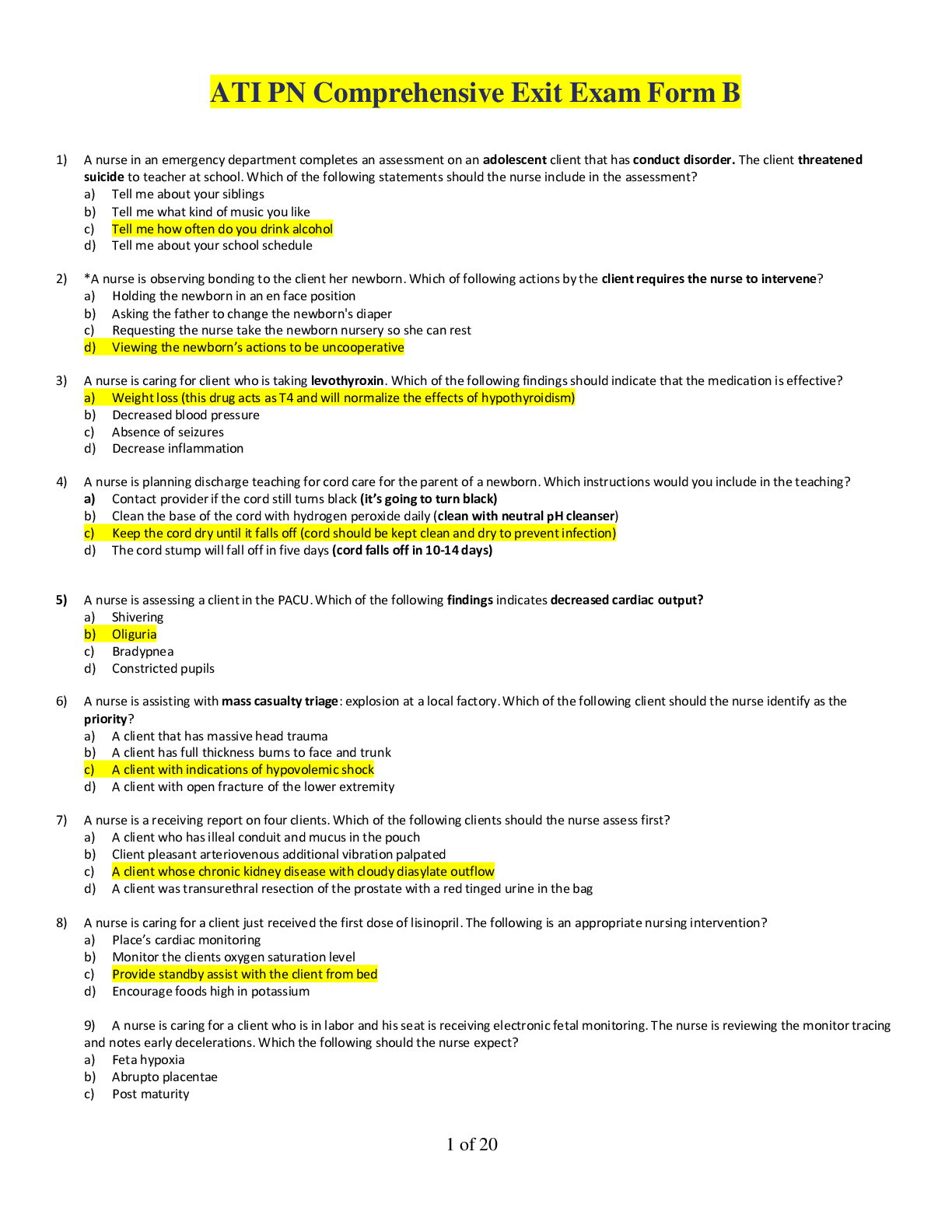
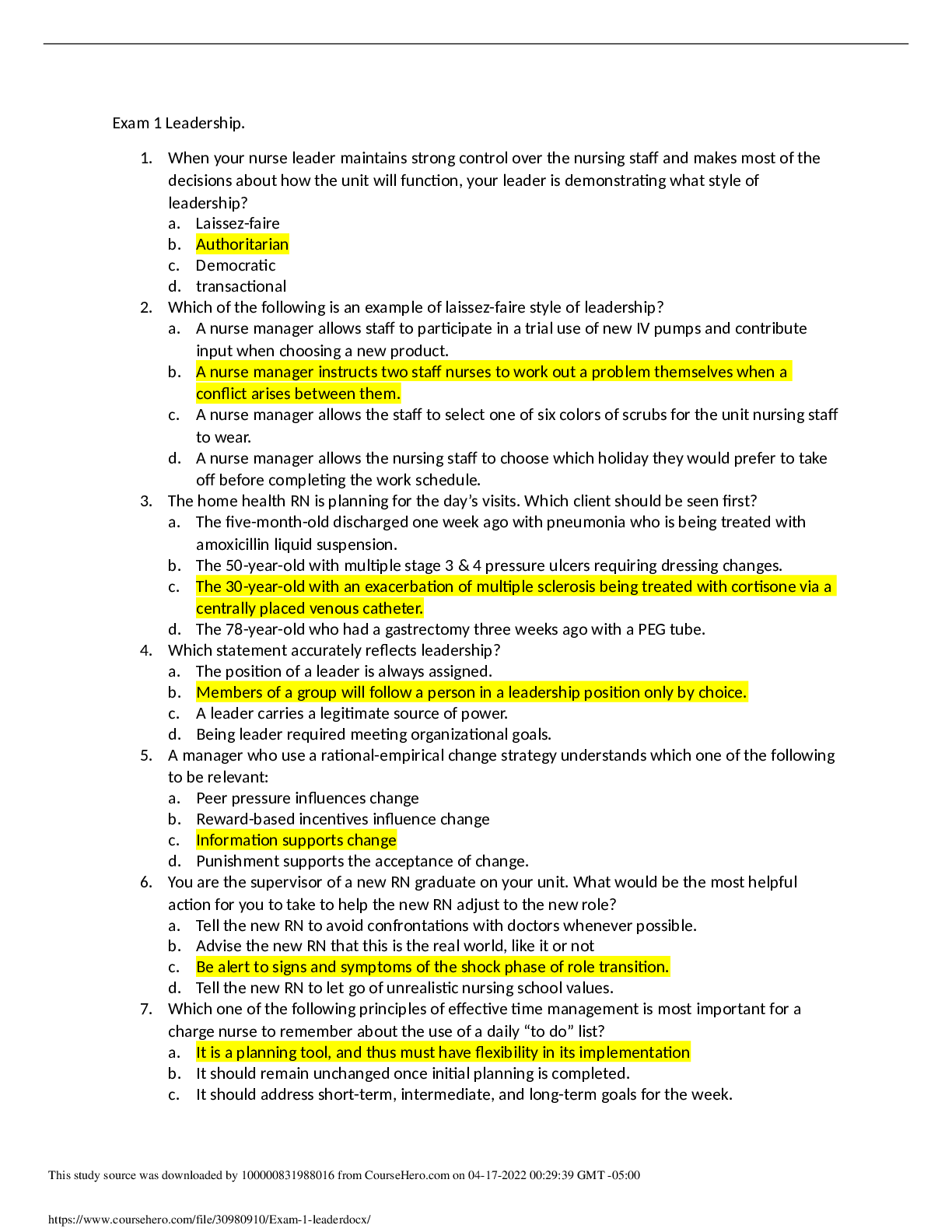


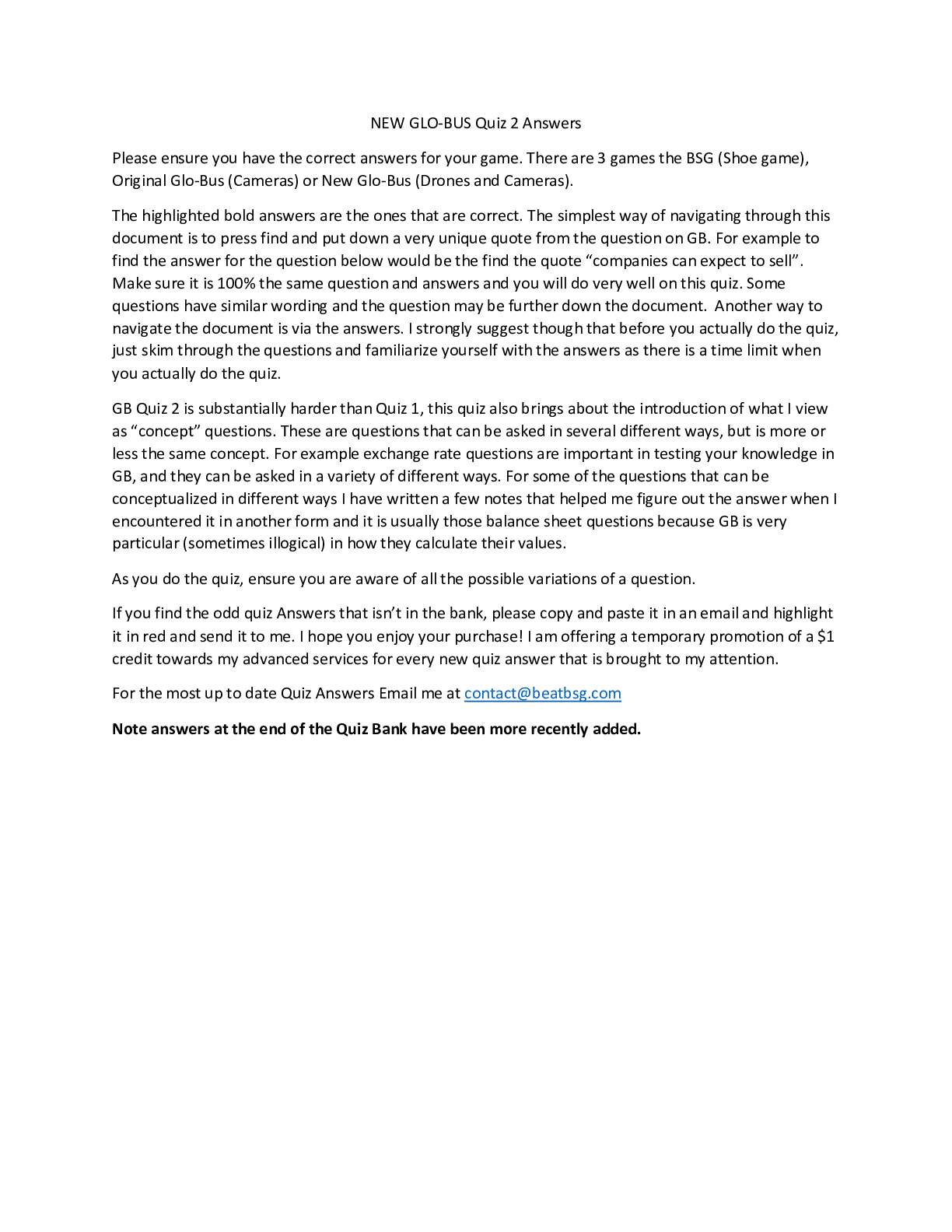
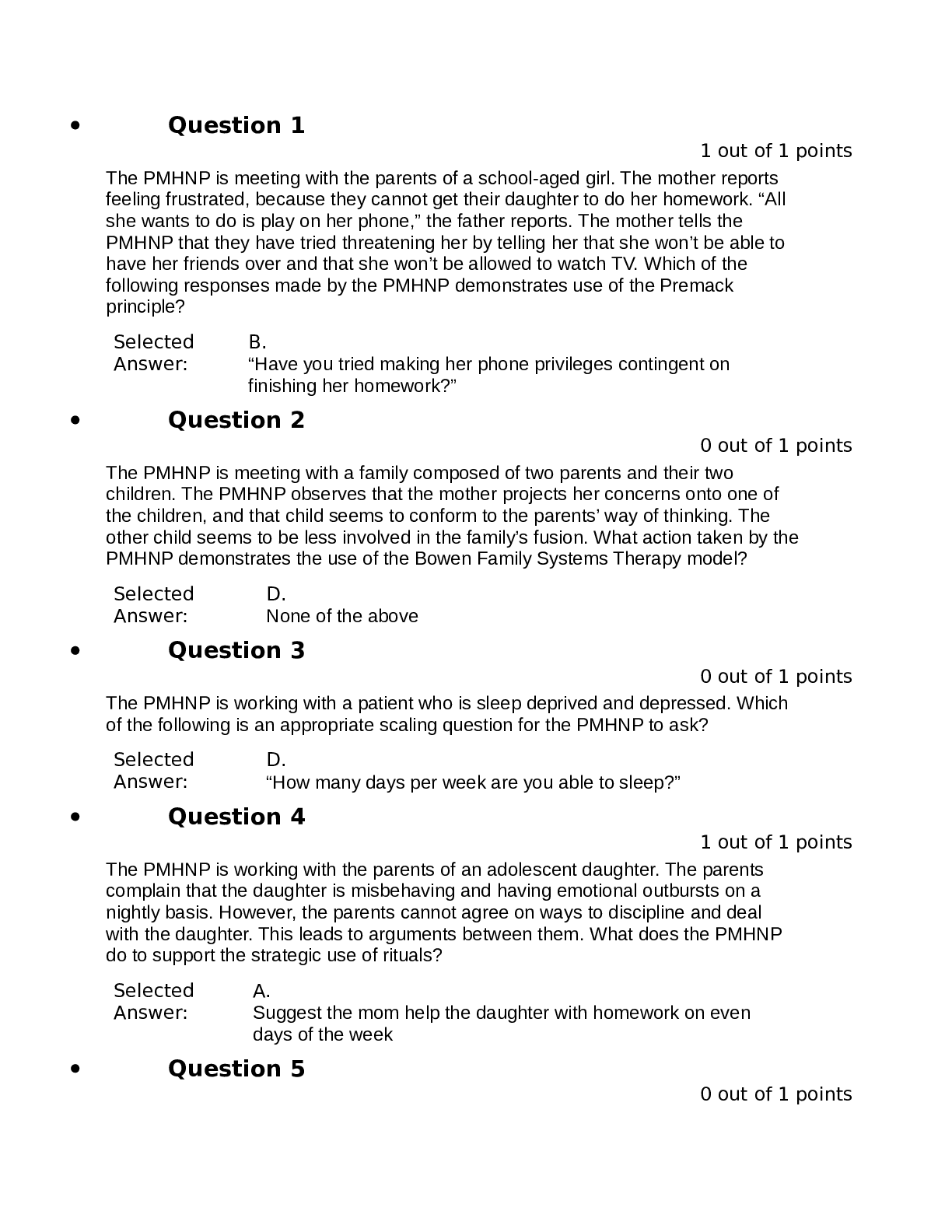
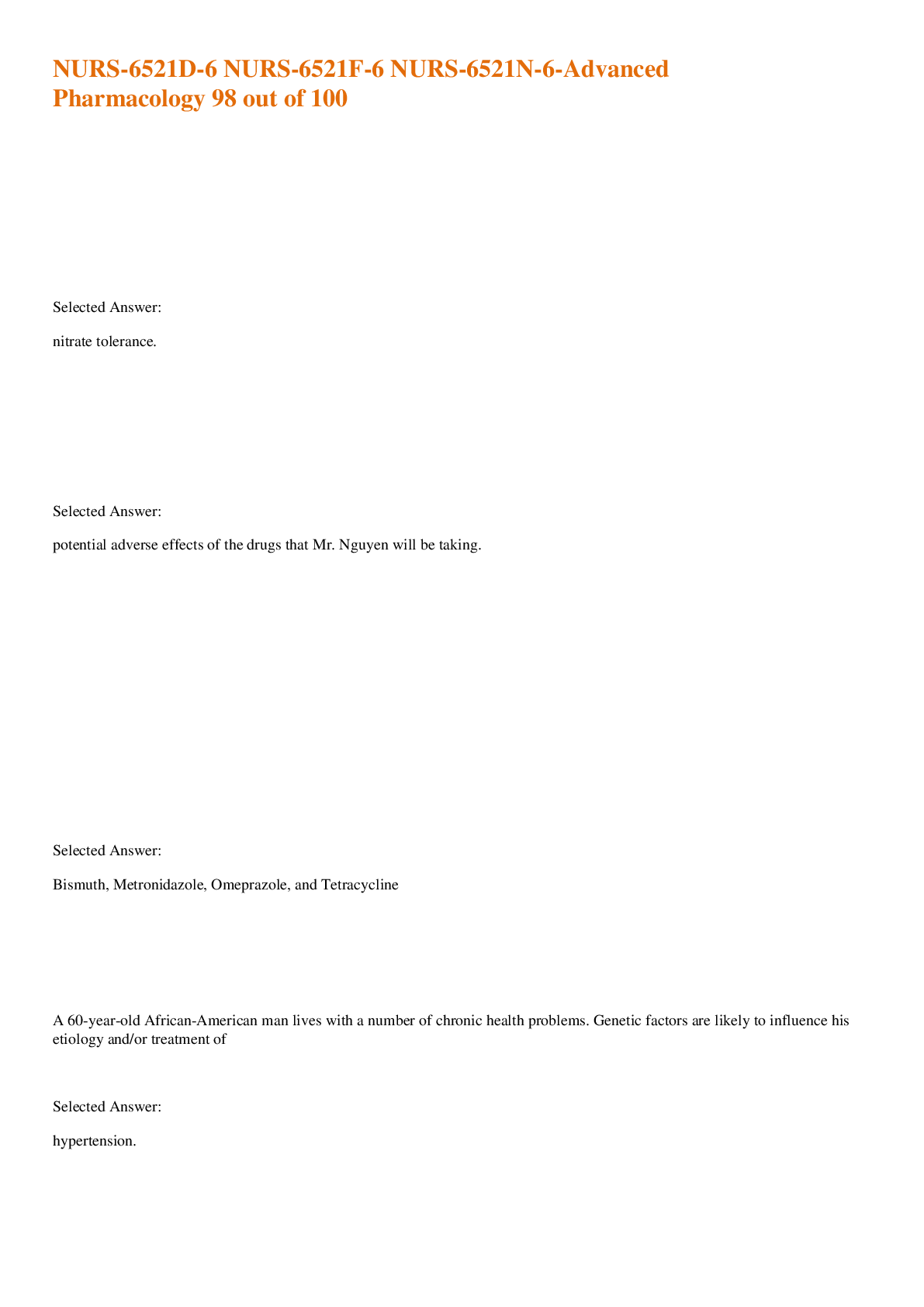
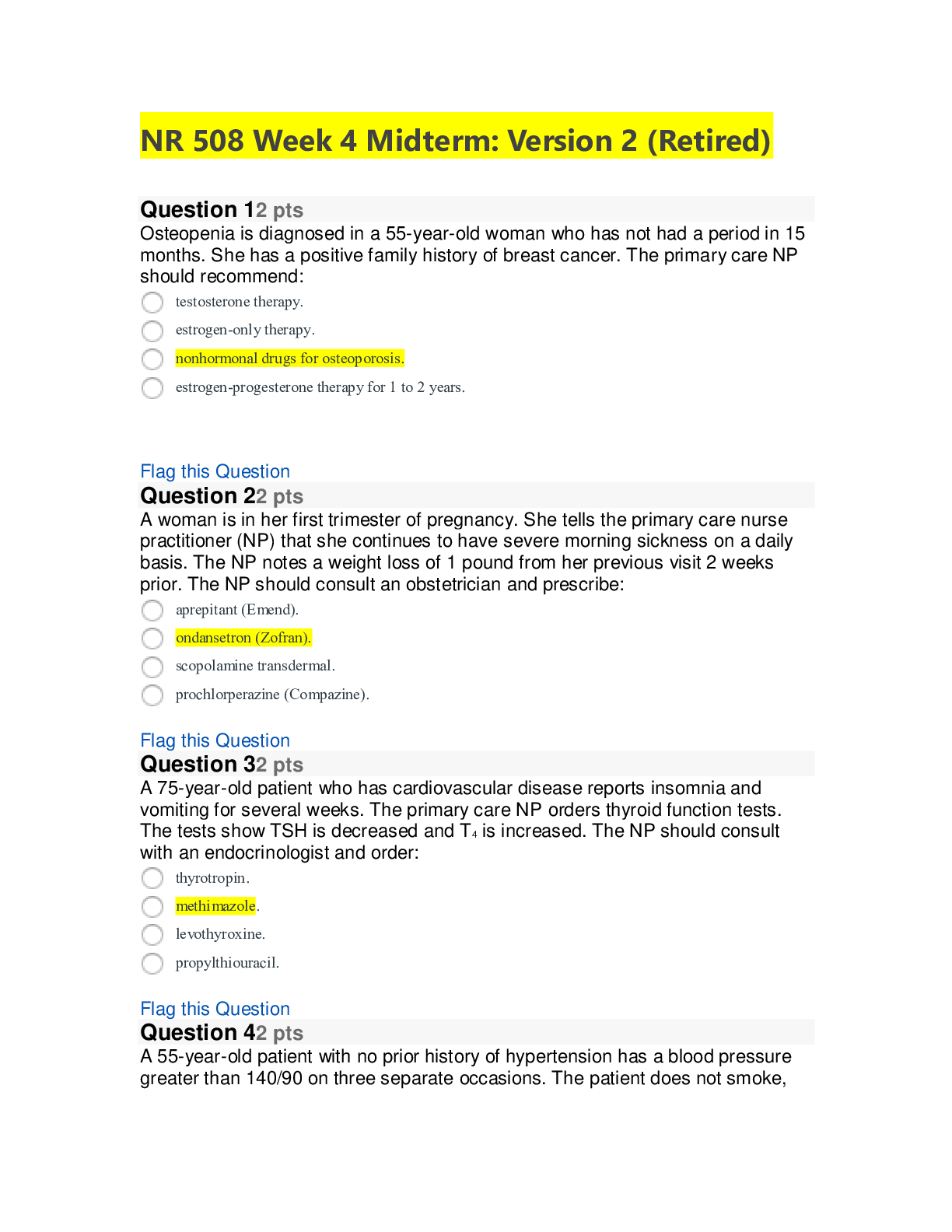



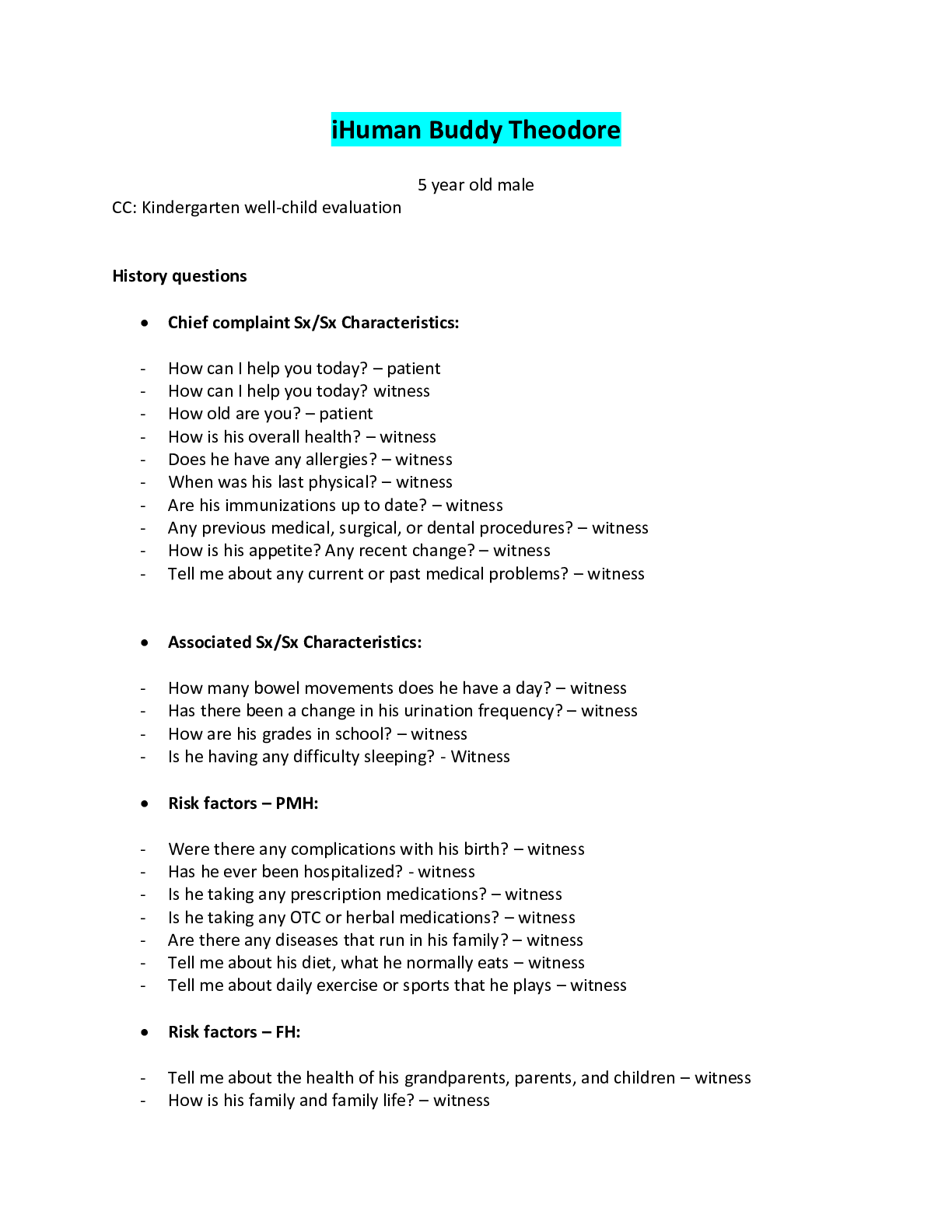

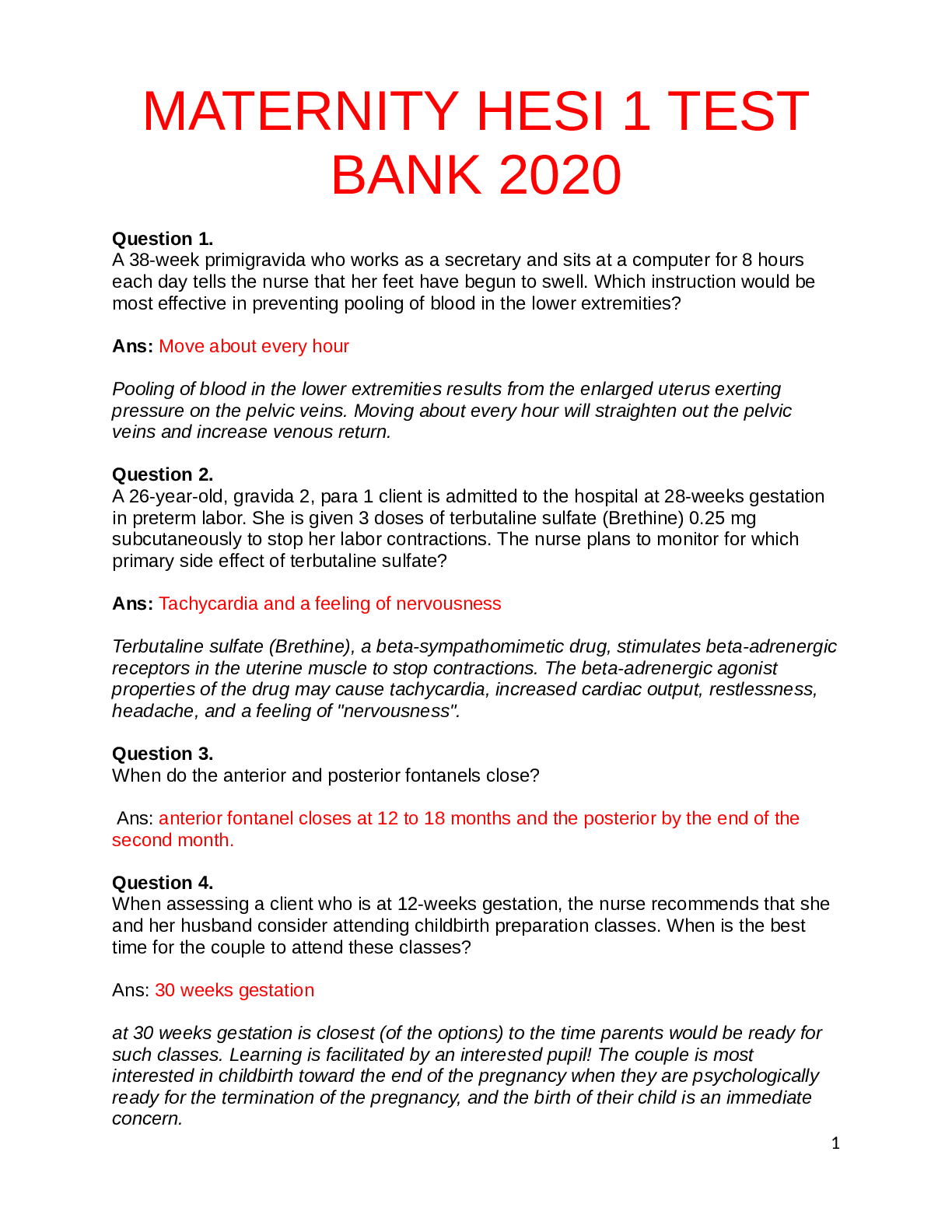

.png)



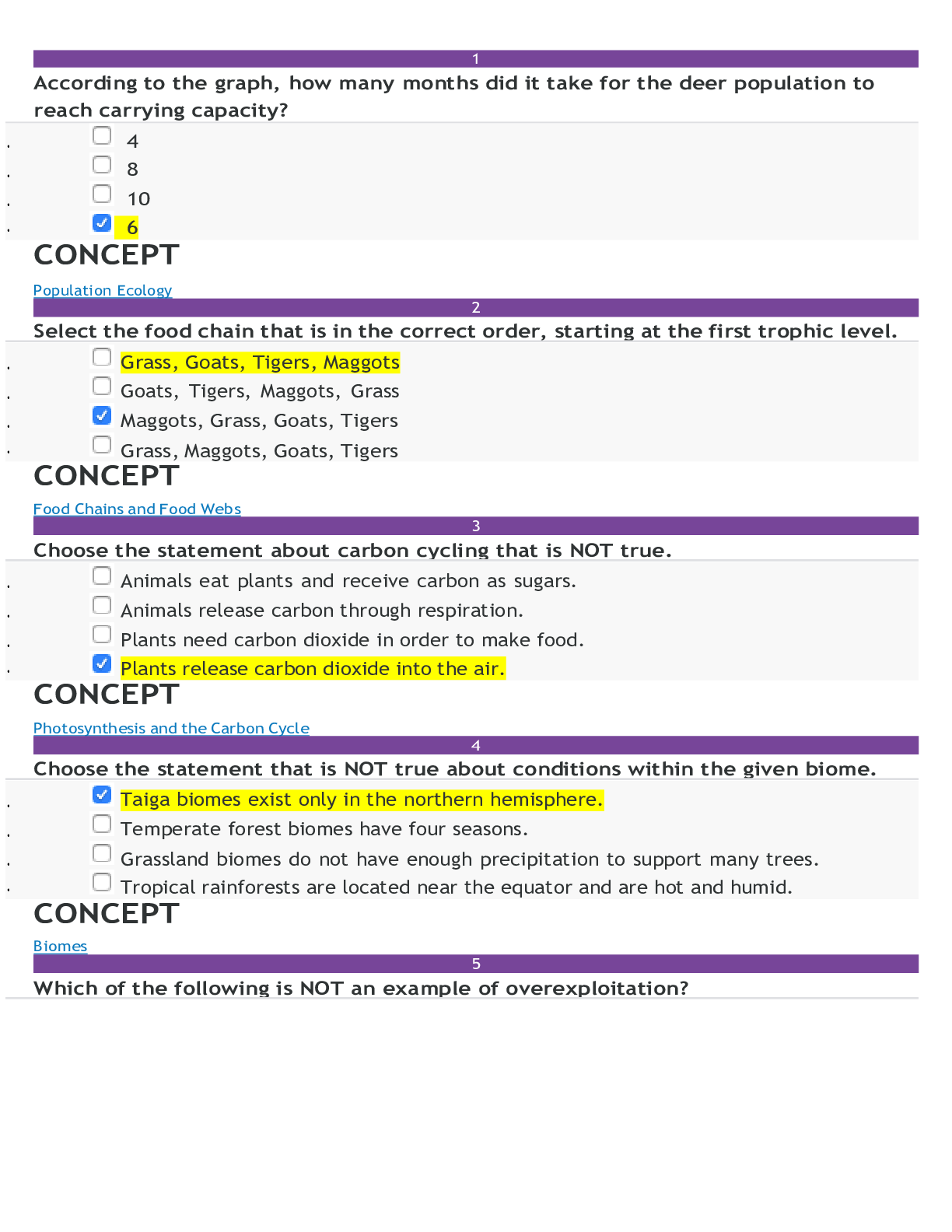
.png)
